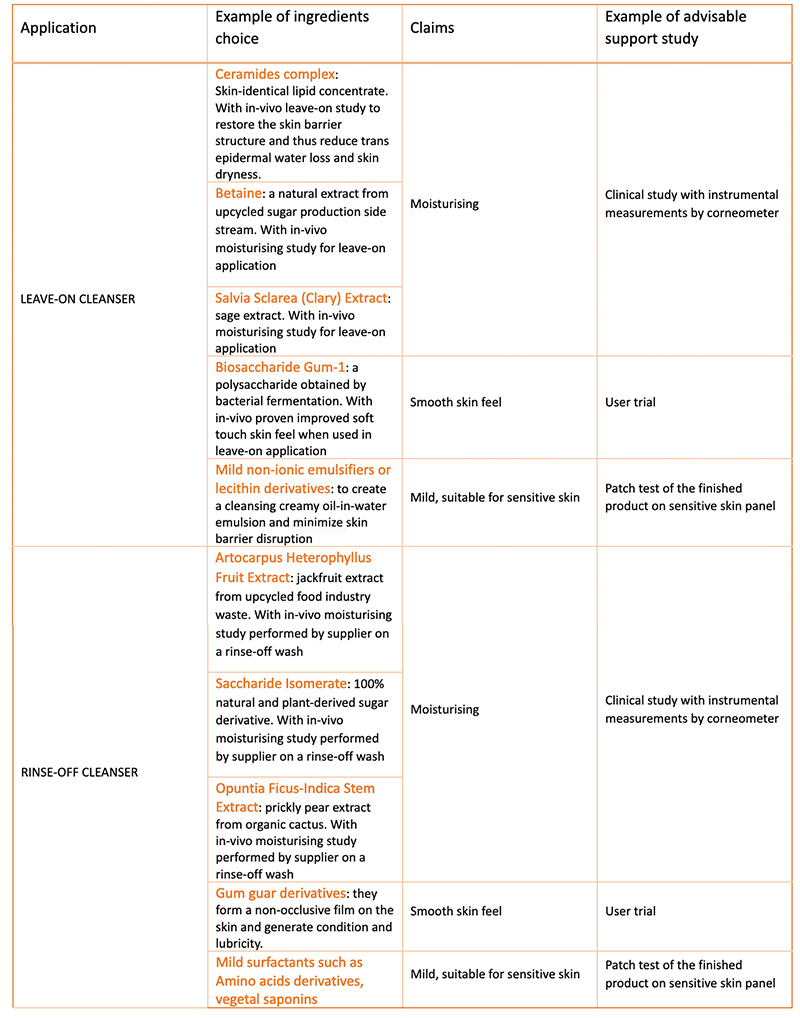Cleansing care: trends
Cleansing is at the base of a beautiful skin complexion. Impurities are removed, skin is refreshed, and senses are relaxed.
Cleansing routines vary around different countries, based on different cultures, skin type and age. Different formats are available, for example gel type of cleansers for oily skin or creamy based for dry skin.
Following the pandemic consumers are even more looking to ingredients which are mild and suitable for sensitive skin. A search of inner wellness together with a respect of the planet are driving trends. Natural, sustainable sourced ingredients are sought.
Meeting the claims
But the consumers’ needs must be met with the promise and the delivery of evident efficacy. Companies are not always aware of how to move into this field. They may look at competitor brands to justify themselves in using similar claims and may be caught by surprise when regulatory bodies find their products’ claims not compliant. Or they are not keen to perform substantiation studies due to costs and timings that need to be built in. They may rely upon claims made by ingredient suppliers, but this could be sufficient only if the finished product is the same formula and has the same application as the one tested by the supplier.
What is the development approach to fulfil all these aspects while complying with the regulations requirements which want claims to be true, honest and supported by suitable evidence?There are different types of claims depending if they are based on the product’s performance, on the ingredients content or on the sensory of the product. The substantiation of the claims can be obtained from existing evidence, from consumers trials or from clinical instrumental studies. Often a combination of all of them is required and consumers’ perception must be taken into account in the choice of claims and their support studies. Claims must be realistic, well defined and clearly communicated to the consumers.
For a formulator the choice of ingredients to meet the claims has become more complex, in particular where claims are not clearly defined or are too broad or open to interpretation. For example, ‘sustainable’, ‘clean beauty’ are claims with no one-for-all definition. Therefore, it is first essential to have a clear communication between the technical team and the brand to define their vision and the objectives claims that their products can achieve as a cosmetic.
A key step for a formulator is then to learn as much as possible on the ingredients they are selecting, with careful review of the data provided by the raw material supplier to make sure the benefits linked to the ingredients are relevant to the claim that needs to be achieved and any evidence provided by the ingredient’s manufacturer is correct.
What to look for to formulate a cleanser with mild ingredients, of natural origin and with a comforting skin feel to suit a sensitive skin?The first requisite of cleansers is to remove unwanted materials but without altering the skin natural barrier properties. Protecting the skin barrier function is very important especially for dry, sensitive skin types.
Mild cleansers like amino acid derivatives, glucose derivatives and vegetal saponins can be an optimal choice as they are less aggressive than some others. These choice cleansers are easy to rinse-off, minimising staying too long onto skin (which could contribute to disrupting the epidermal barrier).
Skin feel is key to complete a positive experience by the consumers when using the product. This can be met by a soft and smooth texture with the aid of rheology modifiers and film formers. A comforting skin feel often goes together with the key claim of a moisturising benefit.
Vegetable extracts rich in mucilage can offer hydrating properties and will meet the use of ingredients of natural origin claim. However, a formulator will not only have to select those with proven hydrating benefits, but make sure the claim is supported by a suitable study on the finished product to verify the benefit.
Application of the product must be considered. For example, some ingredients are renown as excellent skin moisturising agents, but they would only work if left onto skin. These will be suitable for leave-on cleansers. For rinse-off application alternative actives which have proven rinse-off hydration benefits will be chosen instead.
The wording of the claim will also determine the choice of the ingredients and the supporting study. For example, a sensory type of claim like ‘product leaves skin feeling soft’ can be supported by a user trial study, while ‘product moisturises the skin’ will be best substantiated by an instrumental clinical study.
Formulations examples
We can summarise above concepts in below formulations examples and compare choice of ingredients for two different types of skin cleansing application.

Conclusions
For the success of a new product its claims must be identify at early stage during the development process. The claims need to be realistic to meet the expectations of consumers in the desired markets. Claims must be true and compliant not only to avoid going under scrutiny of regulatory bodies, but they will first go under the scrutiny of attentive consumers and the aim is to win their trust. Proven product efficacy is a major attribute to stand out in a competitive market.
The careful choice of ingredients by the formulator and the support of a regulatory advisor are at the basis of a successful development of an effective cosmetic product.
The Cosmetic Experts offer bespoke formulation development and regulatory support. Please get in touch if you are looking to develop a skin cleansing range to meet the latest trends while complying with legal requirements.




